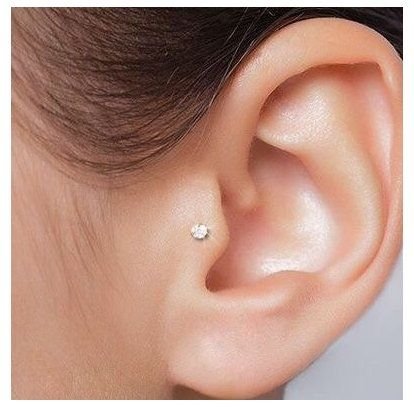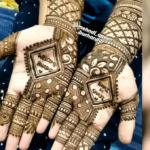In recent years, one of the types of body piercing that has seen the greatest surge in popularity is the tragus piercing. Its understated yet sophisticated appearance has made it appealing to males and females of varying ages. The results of a poll that was carried out in 2021 indicate that around one quarter of individuals who have their ears pierced also have their traguses pierced. The tragus piercing is not only aesthetically pleasing, but it is also thought to have some positive effects on one’s health, including the alleviation of stress and the prevention of migraines.
This article will take a more in-depth look at the tragus piercing, covering topics such as its history, the procedure involved, aftercare instructions, and many more. This article will answer all of your questions, whether you are considering getting a tragus piercing or are simply interested in learning more about the trend.
What is Tragus Piercing
Tragus piercing is done on the triangle cartilage in front of the ear canal. Piercings are common on the tragus since it’s prominent. Tragus piercings can be done with a needle and gun or using a dermal punch or microdermal anchors, which are less painful. Studs, hoops, and barbells can be worn after piercing.
Tragus piercings are a popular body alteration that lets people express themselves. With proper maintenance, tragus piercings heal quickly and painlessly. Tragus piercings are adaptable and elegant body modifications that can personalize your look. A tragus piercing can add elegance or make a statement.
Origins of Tragus Piercings
Tragus piercing has a long and storied history, dating back to religious and cultural practises of ancient civilizations. Egyptian mummies have been found to have evidence of ear piercings, and in tribal cultures, piercings served as a symbol of social position, tribe connection, and religious beliefs.
Body piercing and tattoo culture rose to prominence in the ’90s and ’00s, and it was at this time that the tragus piercing became a trendy current fad. Due to its convenient location and wide range of available jewelry, the tragus piercing quickly rose in popularity. Since then, it has developed into a wide variety of styles and modifications, making it one of the most popular types of piercings.
Even while tragus piercings’ popularity has risen and fallen over the years, they’re still a common way for people to show their unique personalities and sense of style. Tragus piercings have a long and fascinating history, and they continue to develop for both aesthetic and cultural reasons.
Related: Medusa Piercing: A Guide to This Trendy Lip Piercing
Types of Tragus Piercings
1. Traditional Tragus Piercing
A classic tragus piercing consists of making a single hole in the tragus cartilage, and is therefore the most simple and conventional type of tragus piercing. One of the most common and recognisable tragus piercings, it can be embellished with studs, hoops, or even barbells.
2. Forward Tragus Piercing
If you want your jewellery to rest closer to the front of your tragus, you can get a “forward tragus piercing,” which is a modest modification of the standard tragus piercing. If you want to give a traditional piercing a creative spin, this is a terrific option to consider.
3. Industrial Tragus Piercing
A type of tragus piercing known as an industrial tragus piercing features a barbell passing through two separate piercings made in the tragus cartilage and connecting the two holes. This piercing creates an appearance that is more dramatic, making it a popular choice for individuals who are searching for a style that is bold and edgy.
4. Triple Tragus Piercing
A type of tragus piercing known as a triple tragus piercing is one in which the tragus cartilage is punctured in three separate locations with a piercing needle. Those who are trying to make a statement with their body alteration may find that this form of piercing might be an interesting and distinctive option to consider.
Related: Smiley Piercing: A Trending Body Modification
Reasons Why You Should Get a Tragus Piercing
1. Self-expression and style
People get tragus piercings, along with other forms of body modification, so they may showcase their one-of-a-kind personality and excellent sense of style. Because there is such a wide selection of jewelry available for tragus piercings, the piercings can be customized to suit the individual interests and preferences of the person who wears them.
You can go for a more conservative and elegant look with a tragus piercing, or you can go for a look that is riskier and edgier. Either way, it is a great opportunity to express yourself.
2. Pain relief
People who suffer from headaches and migraines may find that getting their tragus pierced provides some relief from the associated agony. Although there is some anecdotal evidence to suggest that the pressure and stimulation of a tragus piercing can help alleviate stress and discomfort, there is not a lot of research to back up these claims scientifically.
3. Improved hearing
There is not the slightest shred of evidence to suggest that getting your tragus pierced can improve your hearing. If the piece of jewellery is too lengthy or too heavy, there is a possibility that it will suddenly obstruct the tragus.
Related: Cartilage Piercings: The Lowdown on Risks, Healing and Style
Risks and Precautions for Tragus Piercing
1. Infection
Anyone who has had their tragus pierced should be aware that there is a considerable risk of infection. This could could place if the area where the piercing was performed is not properly sterilized or if the instruments that were used to do the piercing were not clean. Infections can lead to inflammation, the outflow of pus, pain, and redness in the affected area.
2. Scarring
Scar tissue may develop around a tragus piercing if the piercing becomes infected or if the jewelry worn through the piercing causes the skin to be irritated on a regular basis.
3. Nerve Damage
Tragus piercings have the potential to cause lasting nerve injury due to their location in close proximity to important nerves as well as blood vessels. Damage to a nerve can cause numbness, tingling, or even a complete loss of sensation in the affected area.
4. How You can Minimize the Risk
The following safety measures should be taken to reduce the potential for complications after a tragus piercing:
- Pick a piercer who knows what they’re doing.
- Verify the cleanliness of the piercing tools.
- Pierces should be cleaned with saline solution or an antiseptic on a regular basis.
- You should keep your hands clean and not touch the piercing.
- It’s best to keep the piercing away from any grime or germs.
- Take off anything that might rub against the piercing, such as a tight shirt or a necklace.
- It’s best if you don’t fiddle with the jewellery or twist it too much.
- Protect the piercing from extreme temperatures and toxins.
Related: Ashley Piercing: Ultimate Guide to This Unique Body Modification
Aftercare of Tragus Piercing
1. Cleaning
If you take proper care of your tragus piercing, not only will it heal more quickly, but it will also be less likely to become infected. It is strongly suggested that you clean your piercing several times each day with saline solution or a saline wound wash.
Because alcohol and hydrogen peroxide are both extremely harsh substances that might slow down the healing process, you should avoid using them.
2. Avoid particular activity and substances
For the first few weeks, it’s best to avoid touching your piercing with unwashed hands and sleeping on the side where it is located. For at least a month after getting your piercing, you should also refrain from swimming in pools, hot tubs, or oceans. In addition, there are several foods and beverages that can hinder the healing process or create discomfort, so you should avoid these as well.
3. Healing time of Tragus Piercing
Tragus piercings have a range of healing times, from 4 weeks to 12 weeks. Be patient and adhere to the aftercare recommendations given to you by your piercer during this period. Redness, swelling, discomfort, or discharge are all possible indicators of an infection that necessitate medical attention.
Finding a Professional Piercer
1. Essential Skills for a Professional Piercing
Professional piercers should be trained and certified by the Association of Professional Piercers (APP) or the National Association of Piercing Professionals (NAPP). The local health department can also verify the piercer’s license. A professional piercer should also use sterile equipment and practice good cleanliness to avoid blood-borne diseases.
2. Find a Reliable Piercing Shop
You can find reputable piercing parlours in your neighbourhood by reading reviews written by former clients online. There’s always the option of polling loved ones for suggestions. Check the studio’s cleanliness, the condition of the tools, and the piercer’s demeanour before getting any work done.
3. Ask These Questions Before Getting Pierced
Ask the piercer about their experience and education, the jewellery they use, and the aftercare procedures before letting them pierce you. The healing procedure, as well as any associated dangers or consequences, can be discussed. You should pick a piercer who makes you feel at ease and who is eager to address any concerns you may have.
Related: Dermal Piercing: Everything You Need to Know
Jewelry Options
Types of jewelry available
Tragus jewelry includes captive bead rings, barbells, and studs. Barbells have a straight bar with a ball or gem on each end, while captive bead rings have a little tension-held bead. Studs are barbells with a small post put into the piercing and a decorative end.
Selecting jewelry
When choosing tragus piercing jewellery, consider your style, comfort, and tragus form and size. If you sleep on that side or exercise, choose comfy jewellery. Titanium, gold, and niobium are biocompatible materials for jewelry. Your piercer can help you choose tragus piercing jewelry and explain its materials.
Cost of Tragus Piercing
The cost of a tragus piercing depends on the studio’s location, the piercer’s experience and certifications, and the jewelry you pick. Tragus piercings often cost $40–100.
Before getting your piercing, compare prices and look for specials and promos. Remember that the cheapest choice may not be the best and that a professional piercer with sufficient training and certification is vital for a safe and successful piercing experience.
Budget for the initial piercing expense, aftercare goods like saline solution, and jewelry replacement or upgrades. To minimize surprises, know the exact cost before getting pierced.



